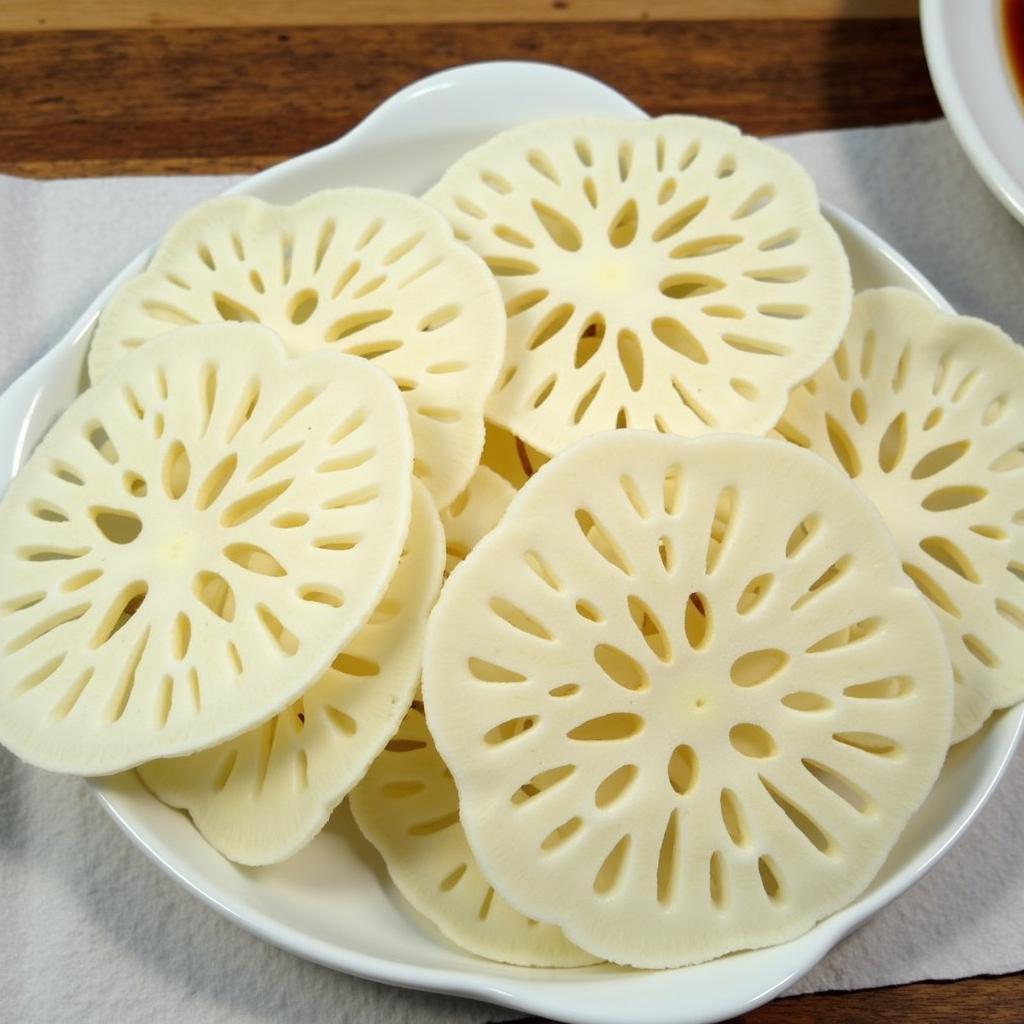Lotus Plant Food, a staple in many Southeast Asian cuisines, is gaining popularity worldwide for its unique flavor and impressive nutritional profile. More than just a beautiful flower, the lotus plant offers a variety of edible parts, each with its own distinct taste and texture. From crunchy seeds to starchy roots, lotus plant food offers a diverse range of culinary possibilities.
 Lotus plant growing in water
Lotus plant growing in water
A Closer Look at the Lotus Plant: From Root to Seed
Every part of the lotus plant, from its roots to its seeds, is edible and boasts a unique flavor profile. This makes it a versatile ingredient in both sweet and savory dishes. Let’s delve deeper into the culinary uses of each part:
- Lotus Root (Rhizome): The crunchy, mildly sweet lotus root is a popular ingredient in stir-fries, soups, and salads. Its neutral flavor also makes it an excellent addition to curries and stews, where it absorbs the surrounding flavors beautifully.
- Lotus Seeds: These small, round seeds have a slightly sweet, nutty flavor reminiscent of almonds. They can be eaten raw, roasted, candied, or ground into flour. Lotus seeds are often used in desserts, snacks, and traditional Chinese medicine.
- Lotus Leaves: While not technically a food, lotus leaves impart a subtle, earthy aroma to dishes. They are commonly used to wrap sticky rice, meat, and other ingredients for steaming or grilling, infusing the food with a unique fragrance.
- Lotus Stems: Similar in texture to celery, lotus stems offer a delicate, slightly sweet flavor. They are commonly used in stir-fries, salads, and pickles.
 Freshly sliced lotus root
Freshly sliced lotus root
The Nutritional Powerhouse: Health Benefits of Lotus Plant Food
Beyond its culinary versatility, lotus plant food is also a nutritional powerhouse. It is low in calories and fat and a good source of:
- Fiber: Aiding digestion and promoting satiety.
- Vitamin C: Boosting the immune system and protecting against cell damage.
- Potassium: Regulating blood pressure and supporting muscle function.
- Iron: Essential for oxygen transport and red blood cell production.
- Antioxidants: Protecting the body from free radical damage.
Incorporating Lotus Plant Food into Your Diet
Integrating lotus plant food into your diet is easier than you might think. Here are a few simple ways to get started:
- Start with the familiar: Try adding sliced lotus root to your next stir-fry or salad.
- Explore new flavors: Venture into traditional Asian recipes featuring lotus seeds in desserts or soups.
- Get creative: Experiment with lotus leaves to infuse your favorite dishes with a unique aroma.
 Traditional Asian lotus seed dessert
Traditional Asian lotus seed dessert
Lotus Plant Food: A Culinary Adventure Awaits
From its delicate flavor to its impressive nutritional profile, lotus plant food offers a unique and exciting culinary adventure. Whether you’re looking to add some variety to your meals or explore the flavors of Southeast Asia, incorporating lotus plant food into your diet is a delicious and healthy choice.
Frequently Asked Questions About Lotus Plant Food
Q: Where can I find lotus plant food?
A: You can find lotus plant food at Asian grocery stores, specialty markets, and some online retailers.
Q: How do I store lotus root?
A: Store fresh lotus root submerged in water in the refrigerator for up to a week.
Q: Are lotus seeds safe to eat raw?
A: While some varieties can be eaten raw, it’s generally recommended to cook lotus seeds before consuming them.
Q: What does lotus root taste like?
A: Lotus root has a mild, slightly sweet flavor with a crunchy texture similar to water chestnuts.
Q: How do I prepare dried lotus seeds?
A: Soak dried lotus seeds in hot water for several hours or overnight before using them in recipes.
For further information on healthy and delicious recipes, explore our other articles like the one on low calorie foods in kerala.
Need help incorporating lotus plant food into your diet? Contact our 24/7 customer service team at 02437655121, email us at minacones@gmail.com, or visit us at 3PGH+8R9, ĐT70A, thôn Trung, Bắc Từ Liêm, Hà Nội, Việt Nam.